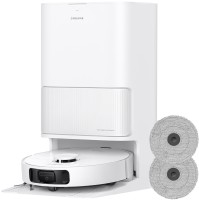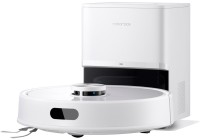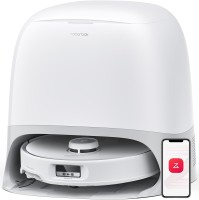How to choose a robot vacuum cleaner: for home, apartment, dry and wet cleaning
We independently test the products and technologies that we recommend.

Types of robot vacuum cleaners
Before you start choosing a robot vacuum cleaner, you need to decide on the type that is needed specifically for you, or rather, to complete the tasks assigned to it:
For dry cleaning. Classic models of robotic vacuum cleaners, which are equipped with brushes and a dust collector and are only able to collect various garbage. This is a modern and more convenient alternative to regular household vacuum cleaners.
For dry and wet cleaning. Combined models are able to simultaneously collect garbage and wipe the floors, for which the set additionally includes a water tank and often a simple microfiber cloth, which is automatically supplied with water. It would seem as a great universal assistant, but this type of robotic vacuums has a few nuances. Firstly, if the house has a lot of carpets, you will have to remove the wet cloth, as wet pile underfoot is not the most pleasant feeling. Although there are advanced models that automatically raise the cloth when they hit the carpet – for example, Roborock S7 MaxV. Secondly, the cloth will have to be washed by hand or with a washing machine – the robot, unfortunately, can't do this. Thirdly, the effectiveness of such wet cleaning is far from the highest, so you still have to do periodic general cleaning. Some manufacturers add vibrating mopping to solve this problem: the washing plate imitates the movements when cleaning the floor by hand, but this still does not give an ideal result.
 |
| Roborock S7 MaxV with the function of dry and wet cleaning. |
Robot polisher. A small number of robots designed only for mopping. Such models are deprived of the dust collection function, but they cope with wet cleaning more efficiently.
Navigation
The quality of cleaning directly depends on the ability of the robot to navigate in space and make the best route. If it does not know how, then there is a possibility that the robot will move randomly, crash into pieces of furniture and other obstacles. As a result, it is likely to spend more time and leave behind uncleaned areas. Basically, these are low-cost devices that are equipped only with collision sensors and a soft bumper that prevents damage to furniture. Faced with any obstacle, it turns around and changes its direction until the next collision.
To avoid this, it is better to choose models with the ability to build a map of the premises. For this, devices can use a set of sensors that form only a simple circuit, a camera and a laser rangefinder (lidar). The latter method is the most effective, since the lidar responds in a timely manner to obstacles and changes in the environment, “sees” in poor lighting conditions, and builds room maps quite accurately. The rangefinder is located in the "turret" on the body, which increases the height of the body by 1 – 2 centimeters, so it is more difficult for such models to pass under low sofas and armchairs. In addition, advanced robots can use a combination of a camera and lidar for navigation, which increases efficiency by 2 times. But such vacuums are not cheap and often belong to the category of premium devices: for example, Xiaomi Mi Robot Vacuum-Mop 2 Ultra or Dreame L10s Ultra.
 |
| Xiaomi Mi Robot Vacuum-Mop 2 Ultra with camera and laser rangefinder for navigation. |
If the device has a camera, the object recognition function can also be implemented: the camera distinguishes objects on the floor, and the robot goes around them. Pet owners will appreciate this option, because the camera recognizes not only slippers and wires, but also animal excrement.
Control
Often, users who buy a robot vacuum cleaner need an autonomous assistant and practically do not interfere with its work: they press a button, start the device and leave it to deal with dirt. But efficient control can improve cleaning efficiency: for example, you can specify the most dirty place so that the vacuum cleaner spends more time on it, edit the room map and set no-go zones so that the appliance does not spill water from the pet bowl. There are several different ways to control the device. The remote control is as simple as possible, but not very convenient, since its functionality is somewhat limited. And why do you need an extra remote control in the house? Many users already have remote controls for TV, air conditioner, audio speakers, lighting and other devices.
Therefore, most manufacturers choose the control method via a smartphone. To do this, you need to install a proprietary application and connect the robot – usually it takes no more than 5 – 10 minutes. Via Bluetooth, you can control the vacuum cleaner in the immediate vicinity, and via Wi-Fi – from anywhere. It is very convenient: start cleaning while you are still at work to return to a clean apartment, or keep your house clean while you are on vacation or on a business trip. The application has much more possibilities than the remote control: in a smartphone, you can adjust the route of the device, set a cleaning schedule, choose specific rooms, check the charge level and change modes. Of course, it all depends on the specific model: for some, the application is less functional, for some manufacturers add even more options, but often the above parameters are standard. In addition, there is a way to control using voice assistants (Google Assistant, Amazon Alexa, etc.), but usually it acts as an addition to other methods. Of course, voice commands are no less convenient and useful feature, but before buying it is better to check which languages the assistant supports. After all, if he speaks only languages that you do not speak, there will be no use of it.
 |
| Controlling a robot vacuum cleaner via an app on a smartphone. |
In addition, pay attention to the modes of operation: the more of them, the better. Basically, this is spot cleaning (in a certain place), zigzag movement, along walls and turbo mode. The ability to schedule cleaning will also be useful: it allows you to set a schedule and days when the vacuum cleaner will automatically clean the whole house or in certain rooms.
For a house or apartment?
Also, before buying, you need to decide on the “working area” – is it a house or an apartment, are there many carpets, are there high thresholds, what is the cleaning area, do pets live with you. Therefore, we advise you to consider the following parameters:
Suction power. On even floor coverings (laminate, linoleum, parquet), garbage can be easily removed even by not very powerful models, but if you have a lot of carpets, especially with high pile, and there are pets, after which fur remains on the floor, it is better to choose a more powerful device. An indicator of about 3000 Pa will be optimal, although there are flagship vacuum cleaners with a suction power of more than 4000 Pa. For example, Sencor SRV 9550 BK claims as much as 8000 Pa, while Tefal X-plorer Serie 95 Total Care RG7987 claims 12000 Pa. In addition, if there are a lot of carpets in the house, the automatic power increase feature will be useful: when the robot drives into the carpet, it automatically increases the suction power without having to manually change the settings.
Battery life. Often, the larger the battery capacity, the more area the vacuum cleaner will clean on a single charge. But it also depends on the accuracy of mapping and determining the route: if the device is well oriented in the room, does not re-enter the cleaned areas, then the process will be completed much faster. Of course, modern models are able to independently return to the charging station and continue cleaning after charging, but cleaning that lasts half a day is unlikely to please anyone. Therefore, if you have a large house, choose devices with high battery life. For comparison, in 40 – 50 minutes the device will clean only a one-room apartment. It is convenient that manufacturers often indicate not only the operating time on a single charge, but also the area that the assistant is able to clean during this time.
Shape and dimensions. Round body shape is traditional for robot vacuum cleaners, but there are also square and D-shaped models. It only affects the quality of cleaning along the walls and in the corners: it is easier for a square vacuum cleaner to reach the corner than for a round one. Much more important are the dimensions of the device, or rather, the height of its body: a small thickness allows it to drive under low furniture.
 |
| Electrolux Pure i9.2 PI92 4ANM with a D-shaped body. |
In box. The minimum requirement for any robot vacuum cleaner is the presence of a main brush and one side brush in the equipment. Two side brushes capture more dirt, thus speeding up the process and improving the quality of cleaning in hard-to-reach places – in the corners and along walls. If the model supports wet cleaning, the set also includes a small cloth, which is automatically supplied with water. Some manufacturers add additional consumables: spare fabric clothes and side brushes. The more is in box, the better, because over time you will not have to spend money on buying new products. In addition, the set may include special magnetic tapes and infrared transmitters for building virtual walls – in other words, restricted areas where the vacuum cleaner does not need to go. But it is much more convenient if such a function is provided in a mobile application.
Dust collector capacity. In this case, the rule “the more the better” also works. Unlike regular vacuum cleaners, robots are more compact and, accordingly, have less capacious dust collectors. If the device also supports wet cleaning, it is also necessary to place a water tank inside. In general, so that you do not have to interrupt cleaning to empty the dust container, it is better to choose models with a tank capacity of about 500 ml. Again, the frequency of its cleaning directly depends on the degree of contamination and the size of the house. And definitely a special indicator of filling the dust container will be useful.
Thresholds. Before buying, we advise you to carefully inspect your apartment or house and measure the height of the thresholds. Often, robots cannot overcome obstacles over 2 cm, but if your thresholds are higher, you will have to carry it manually.
HEPA filter. Fine filter, in our opinion, should be mandatory both in simple household vacuum cleaners and in robots. It is designed to clean the air from dust and small particles, which is especially important for families with small children and people with allergies.
Sensors and floor maps. If you are the owner of a houses with several floors, the ability to build and memorize maps of individual floors, as well as the presence of special sensors that prevent the device from falling off the stairs, will be very useful. And if the second function is quite standard, then the first is not so common. For example, Roborock S6 MaxV can build room maps on 4 floors.
Additional features
To attract the attention of the buyer, any product must have some unique features and stand out from the competitors. Often, such features are of no use and are only needed for marketing, but there are also really useful functions. So, what to pay attention to, and what can you safely pass by?
Security camera. Some of the cameras that are used to build maps are also designed for video surveillance: you can remotely view the picture and control the cleaning process. Of course, this is a matter of taste, but the ability to see socks or children's toys left on the floor is hardly such a necessary option. If you need full-fledged video surveillance, it is better to install a regular camera that will shoot the entire room, and not just the floor.
Self-cleaning station. To fully automate the process and make device maintenance easier and more convenient, some manufacturers add a self-cleaning station. This is the base where the robot not only charges, but also unloads the collected garbage. Typically, such stations are equipped with a large bag, which must be changed periodically – depending on the volume and frequency of cleaning, it can last from several weeks to several months. There are models with stations to choose from that clean only dry garbage or also “wash” wipes for wet cleaning. For example, Dreame Bot W10 Pro can't empty the dust container, but it cleans dirty cloth (there are two of them, by the way, and they rotate during operation). And the ECOVACS Deebot Ozmo X1 OMNI station collects garbage in a 3-liter disposable bag, rinses off dirty water, collects clean water in the tank, rinses the nozzles and dries them with hot air.
 |
| Advanced self-cleaning station of the ECOVACS Deebot Ozmo X1 OMNI robot vacuum cleaner. |
Ultraviolet lamp. Ultraviolet should kill harmful bacteria and germs on the floor, but in a few seconds, while the vacuum cleaner passes a specific area, you are unlikely to get effective disinfection. Moreover, the UV lamp affects battery life and quickly discharges it.
Which brand to choose?
Often the quality of a vacuum cleaner does not depend on the company that released it, as manufacturers have models from different price segments with different capabilities in their assortment. But still, it is better to buy products from well-known brands that have experience in the production of such devices. So you can evaluate the advantages and disadvantages of the model in advance, having read customer reviews, easily find consumables and hand over the device to a service center in case of a breakdown. To date, Xiaomi, Roborock, Dreame, iRobot, Samsung robot vacuum cleaners are the most popular, but this is only a part of a large number of experienced, well-known and reliable manufacturers.
Articles, reviews, useful tips
All materials












































































